Multifield-Controlled Terahertz Hybrid Metasurface for Switches and Logic Operations
Abstract
1. Introduction
2. Materials and Methods
3. Results and Discussions
3.1. Simulation of Electrically Tuned VO2 Bridges
3.2. Simulation of Optically Tuned Ge Layers
3.3. Logic Operation Controlled by a Multifield
4. Conclusions
Supplementary Materials
Author Contributions
Funding
Institutional Review Board Statement
Informed Consent Statement
Data Availability Statement
Conflicts of Interest
References
- Ma, J.J.; Shrestha, R.; Adelberg, J.; Yeh, C.Y.; Hossain, Z.; Enightly, E.; Jornet, J.M.; Mittleman, D.M. Security and eavesdropping in terahertz wireless links. Nature 2018, 563, 89–93. [Google Scholar] [CrossRef] [PubMed]
- Meijer, A.S.; Berden, G.; Arslanov, D.D.; Ozerov, M.; Jongma, R.T.; van der Zande, W.J. An ultrawide-bandwidth single-sideband modulator for terahertz frequencies. Nat. Photonics 2016, 10, 740–744. [Google Scholar] [CrossRef]
- Boulogeorgos, A.A.A.; Alexiou, A.; Merkle, T.; Schubert, C.; Elschner, R.; Katsiotis, A.; Stavrianos, P.; Kritharidis, D.; Chartsias, P.K.; Kokkoniemi, J.; et al. Terahertz Technologies to Deliver Optical Network Quality of Experience in Wireless Systems Beyond 5G. IEEE Commun. Mag. 2018, 56, 144–151. [Google Scholar] [CrossRef]
- Nagatsuma, T.; Horiguchi, S.; Minamikata, Y.; Yoshimizu, Y.; Hisatake, S.; Kuwano, S.; Yoshimoto, N.; Terada, J.; Takahashi, H. Terahertz wireless communications based on photonics technologies. Opt. Express 2013, 21, 23736–23747. [Google Scholar] [CrossRef] [PubMed]
- Seeds, A.J.; Shams, H.; Fice, M.J.; Renaud, C.C. TeraHertz Photonics for Wireless Communications. J. Light. Technol. 2015, 33, 579–587. [Google Scholar] [CrossRef]
- Nagatsuma, T.; Ducournau, G.; Renaud, C.C. Advances in terahertz communications accelerated by photonics. Nat. Photonics 2016, 10, 371–379. [Google Scholar] [CrossRef]
- Zeng, H.X.; Liang, H.J.; Zhang, Y.X.; Wang, L.; Liang, S.X.; Gong, S.; Li, Z.; Yang, Z.Q.; Zhang, X.L.; Lan, F.; et al. High-precision digital terahertz phase manipulation within a multichannel field perturbation coding chip. Nat. Photonics 2021, 15, 751–757. [Google Scholar] [CrossRef]
- Ramachandran, T.; Faruque, M.R.I.; Islam, M.T.; Khandaker, M.U.; Alqahtani, A.; Bradley, D.A. Development and Analysis of Coding and Tailored Metamaterial for Terahertz Frequency Applications. Materials 2022, 15, 2777. [Google Scholar] [CrossRef]
- Liu, S.; Cui, T.J.; Zhang, L.; Xu, Q.; Wang, Q.; Wan, X.; Gu, J.Q.; Tang, W.X.; Qi, M.Q.; Han, J.G.; et al. Convolution Operations on Coding Metasurface to Reach Flexible and Continuous Controls of Terahertz. Adv. Sci. 2016, 3, 1600156. [Google Scholar] [CrossRef]
- Cai, T.; Tang, S.W.; Bin, Z.; Wang, G.M.; Ji, W.Y.; Qian, C.; Wang, Z.J.; Li, E.P.; Chen, H.S. Ultrawideband chromatic aberration-free meta-mirrors. Adv. Photonics 2021, 3, 16001. [Google Scholar] [CrossRef]
- Guo, W.L.; Wang, G.M.; Luo, X.Y.; Chen, K.; Li, H.P.; Feng, Y.J. Dual-Phase Hybrid Metasurface for Independent Amplitude and Phase Control of Circularly Polarized Wave. IEEE Trans. Antennas Propag. 2020, 68, 7705–7710. [Google Scholar] [CrossRef]
- Yu, N.F.; Genevet, P.; Kats, M.A.; Aieta, F.; Tetienne, J.P.; Capasso, F.; Gaburro, Z. Light Propagation with Phase Discontinuities: Generalized Laws of Reflection and Refraction. Science 2011, 334, 333–337. [Google Scholar] [CrossRef]
- Cai, T.; Zheng, B.; Lou, J.; Shen, L.; Yang, Y.H.; Tang, S.W.; Li, E.; Qian, C.; Chen, H.S. Experimental Realization of a Superdispersion-Enabled Ultrabroadband Terahertz Cloak. Adv. Mater. 2020, 34, 2205053. [Google Scholar] [CrossRef]
- Zheludev, N.I.; Kivshar, Y.S. From metamaterials to metadevices. Nat. Mater. 2012, 11, 917–924. [Google Scholar] [CrossRef]
- Hu, Y.Z.; You, J.; Tong, M.Y.; Zheng, X.; Xu, Z.J.; Cheng, X.G.; Jiang, T. Pump-Color Selective Control of Ultrafast All-Optical Switching Dynamics in Metaphotonic Devices. Adv. Sci. 2020, 7, 2000799. [Google Scholar] [CrossRef]
- Gupta, M.; Srivastava, Y.K.; Singh, R. A Toroidal Metamaterial Switch. Adv. Mater. 2018, 30, 1704845. [Google Scholar] [CrossRef]
- Lou, J.; Ma, H.; Wang, J.; Yang, R.S.; Dong, B.W.; Yu, Y.; Wang, J.F.; Zhang, F.L.; Fan, Y.C.; Feng, M.D.; et al. Multifield-Inspired Tunable Carrier Effects Based on Ferroelectric-Silicon PN Heterojunction. Adv. Electron. Mater. 2020, 6, 1900795. [Google Scholar] [CrossRef]
- Shen, L.; Lin, X.; Shalaginov, M.Y.; Low, T.; Zhang, X.M.; Zhang, B.L.; Chen, H.S. Broadband enhancement of on-chip single-photon extraction via tilted hyperbolic metamaterials. Appl. Phys. Rev. 2020, 7, 021403. [Google Scholar] [CrossRef]
- Chowdhury, D.R.; Singh, R.; O’Hara, J.F.; Chen, H.T.; Taylor, A.J.; Azad, A.K. Dynamically reconfigurable terahertz metamaterial through photo-doped semiconductor. Appl. Phys. Lett. 2011, 99, 231101. [Google Scholar] [CrossRef]
- Jeong, Y.G.; Bahk, Y.M.; Kim, D.S. Dynamic Terahertz Plasmonics Enabled by Phase-Change Materials. Adv. Opt. Mater. 2019, 8, 1900548. [Google Scholar] [CrossRef]
- Gopalan, P.; Sensale-Rodriguez, B. 2D Materials for Terahertz Modulation. Adv. Opt. Mater. 2019, 8, 1900550. [Google Scholar] [CrossRef]
- Hu, T.Z.; Jiang, T.; Zhou, J.H.; Hao, H.; Sun, H.; Ouyang, H.; Tong, M.Y.; Tang, Y.X.; Li, H.; You, J.; et al. Ultrafast terahertz transmission/group delay switching in photoactive WSe2-functionalized metaphotonic devices. Nano Energy 2020, 68, 104280. [Google Scholar] [CrossRef]
- Das, S.; Wang, Y.D.; Dai, Y.Y.; Li, S.S.; Sun, Z.P. Ultrafast transient sub-bandgap absorption of monolayer MoS2. Light Sci. Appl. 2021, 10, 27. [Google Scholar] [CrossRef]
- Lee, K.; Li, J.; Cheng, L.; Wang, J.; Kumar, D.; Wang, Q.S.; Chen, M.J.; Wu, Y.; Eda, G.; Chia, E.E.M.; et al. Sub-Picosecond Carrier Dynamics Induced by Efficient Charge Transfer in MoTe2/WTe2 van der Waals Heterostructures. ACS Nano 2019, 13, 9587–9594. [Google Scholar] [CrossRef] [PubMed]
- Chanana, A.; Liu, X.J.; Zhang, C.; Vardeny, Z.V.; Nahata, A. Ultrafast frequency-agile terahertz devices using methylammonium lead halide perovskites. Sci. Adv. 2018, 4, eaar7353. [Google Scholar] [CrossRef] [PubMed]
- Zhong, Y.C.; Tang, B.; Fei, M.; Jie, Q.; Tan, J.Q.; Wang, Q.Q.; Liang, S.; Du, J.J.; Zhang, L.; Dong, H.X.; et al. All-Photonic Miniature Perovskite Encoder with a Terahertz Bandwidth. Laser Photonics Rev. 2020, 14, 1900398. [Google Scholar] [CrossRef]
- Li, Z.Q.; Liu, X.Y.; Zuo, C.L.; Yang, W.; Fang, X.S. Supersaturation-Controlled Growth of Monolithically Integrated Lead-Free Halide Perovskite Single-Crystalline Thin Film for High-Sensitivity Photodetectors. Adv. Mater. 2021, 33, 2103010. [Google Scholar] [CrossRef]
- Dai, Z.J.; Manjappa, M.; Yang, Y.K.; Tan, T.C.W.; Qiang, B.; Han, S.; Wong, L.J.; Xiu, F.X.; Liu, W.W.; Singh, R. High Mobility 3D Dirac Semimetal (Cd3As2) for Ultrafast Photoactive Terahertz Photonics. Adv. Funct. Mater. 2021, 31, 2011011. [Google Scholar] [CrossRef]
- Ding, F. A Review of Multifunction Optical Gap-Surface Plasmon Metasurfaces. Prog. Electromagn. Res. 2020, 174, 55–73. [Google Scholar] [CrossRef]
- Goulain, P.; Koulouklidis, A.D.; Manceau, J.M.; Daskalaki, C.; Paulillo, B.; Maussang, K.; Dhillon, S.; Freeman, J.R.; Li, L.H.; Linfield, E.H.; et al. Femtosecond Broadband Frequency Switch of Terahertz Three-Dimensional Meta-Atoms. ACS Photonics 2021, 8, 1097–1102. [Google Scholar] [CrossRef]
- Lou, J.; Liang, J.G.; Yu, Y.; Ma, H.; Yang, R.S.; Fan, Y.C.; Wang, G.M.; Cai, T. Silicon-Based Terahertz Meta-Devices for Electrical Modulation of Fano Resonance and Transmission Amplitude. Adv. Opt. Mater. 2020, 8, 2000449. [Google Scholar] [CrossRef]
- Meng, C.; Thrane, P.C.V.; Bozhevolnyi, S.I. Full-range birefringence control with piezoelectric MEMS-based metasurfaces. Nat. Commun. 2020, 13, 2071. [Google Scholar] [CrossRef]
- Zhang, J.; Hu, X.F.; Chen, H.S.; Gao, F. Designer Surface Plasmons Enable Terahertz Cherenkov Radiation. Prog. Electromagn. Res. 2020, 169, 25–32. [Google Scholar] [CrossRef]
- Liu, X.D.; Chen, H.; Liang, S.X.; Zhang, M.; Jiang, Z.D.; Fan, S.T.; Sun, Y.W. Ultrabroadband electrically controllable terahertz modulation based on GaAs Schottky diode structure. APL Photonics 2021, 6, 111301. [Google Scholar] [CrossRef]
- Liu, X.B.; Wang, Q.; Zhang, X.Q.; Li, H.; Xu, Q.; Xu, Y.H.; Chen, X.Y.; Li, S.X.; Liu, M.; Tian, Z.; et al. Thermally Dependent Dynamic Meta-Holography Using a Vanadium Dioxide Integrated Metasurface. Adv. Opt. Mater. 2019, 7, 1900175. [Google Scholar] [CrossRef]
- Lee, S.; Kim, W.T.; Kang, J.H.; Kang, B.J.; Rotermund, F.; Park, Q.H. Single-Layer Metasurfaces as Spectrally Tunable Terahertz Half- and Quarter-Waveplates. ACS Appl. Mater. Interfaces 2019, 11, 7655–7660. [Google Scholar] [CrossRef]
- Zhang, M.; Ma, X.L.; Pu, M.B.; Liu, K.P.; Guo, Y.H.; Huang, Y.J.; Xie, X.; Li, X.; Yu, H.L.; Luo, X.G. Large-Area and Low-Cost Nanoslit-Based Flexible Metasurfaces for Multispectral Electromagnetic Wave Manipulation. Adv. Opt. Mater. 2019, 7, 1900657. [Google Scholar] [CrossRef]
- Fan, X.Q.; Li, Y.H.; Chen, S.H.; Xing, Y.F.; Pan, T.S. Mechanical Terahertz Modulation by Skin-Like Ultrathin Stretchable Metasurface. Small 2020, 16, 2002484. [Google Scholar] [CrossRef]
- Degl’Innocenti, R.; Kindness, S.J.; Beere, H.E.; Ritchie, D.A. All-integrated terahertz modulators. Nanophotonics 2018, 7, 127–144. [Google Scholar] [CrossRef]
- Shrekenhamer, D.; Chen, W.C.; Padilla, W.J. Liquid Crystal Tunable Metamaterial Absorber. Phys. Rev. Lett. 2013, 110, 177403. [Google Scholar] [CrossRef]
- Kowerdziej, P.; Stanczyk, T.; Parka, J. Electromagnetic simulations of tunable terahertz metamaterial infiltrated with highly birefringent nematic liquid crystal. Liq. Cryst. 2015, 42, 430–434. [Google Scholar] [CrossRef]
- Chen, X.Y.; Zhang, S.J.; Liu, K.; Li, H.Y.; Xu, Y.H.; Chen, J.J.; Lu, Y.C.; Wang, Q.W.; Feng, X.; Wang, K.M.; et al. Reconfigurable and Nonvolatile Terahertz Metadevices Based on a Phase-Change Material. ACS Photonics 2022, 9, 1638–1646. [Google Scholar] [CrossRef]
- Wang, Y.F.; Landreman, P.; Schoen, D.; Okabe, K.; Marshall, A.; Celano, U.; Wong, H.S.P.; Park, J.; Brongersma, M.L. Electrical tuning of phase-change antennas and metasurfaces. Nat. Nanotechnol. 2021, 16, 667–672. [Google Scholar] [CrossRef] [PubMed]
- Song, Z.Y.; Chen, A.P.; Zhang, J.H. Terahertz switching between broadband absorption and narrowband absorption. Opt. Express 2020, 28, 2037–2044. [Google Scholar] [CrossRef] [PubMed]
- Liu, M.K.; Hwang, H.Y.; Tao, H.; Strikwerda, A.C.; Fan, K.B.; Keiser, G.R.; Sternbach, A.J.; West, K.G.; Kittiwatanakul, S.; Lu, J.W.; et al. Terahertz-field-induced insulator-to-metal transition in vanadium dioxide metamaterial. Nature 2012, 487, 345–348. [Google Scholar] [CrossRef]
- Kabir, S.; Nirantar, S.; Zhu, L.C.; Ton-That, C.; Jain, S.K.; Kayani, A.B.; Murdoch, B.J.; Sriram, S.; Walia, S.; Bhaskaran, M. Phase change vanadium dioxide light sensors. Appl. Mater. Today 2020, 21, 100833. [Google Scholar] [CrossRef]
- Ding, F.; Zhong, S.M.; Bozhevolnyi, S.I. Vanadium Dioxide Integrated Metasurfaces with Switchable Functionalities at Terahertz Frequencies. Adv. Opt. Mater. 2018, 6, 1701204. [Google Scholar] [CrossRef]
- Li, X.K.; Tang, S.W.; Ding, F.; Zhong, S.M.; Yang, Y.Q.; Jiang, T.; Zhou, J. Switchable multifunctional terahertz metasurfaces employing vanadium dioxide. Sci. Rep. 2019, 9, 5454. [Google Scholar] [CrossRef]
- Hu, Y.Z.; Tong, M.Y.; Xu, Z.J.; Cheng, X.G.; Jiang, T. Spatiotemporal Terahertz Metasurfaces for Ultrafast All-Optical Switching with Electric-Triggered Bistability. Laser Photonics Rev. 2021, 15, 2000456. [Google Scholar] [CrossRef]
- Lu, C.; Lu, Q.J.; Gao, M.; Lin, Y. Dynamic Manipulation of THz Waves Enabled by Phase-Transition VO2 Thin Film. Nanomaterrials 2021, 11, 114. [Google Scholar] [CrossRef]
- Ulbricht, R.; Hendry, E.; Shan, J.; Heinz, T.F.; Bonn, M. Carrier dynamics in semiconductors studied with time-resolved terahertz spectroscopy. Rev. Mod. Phys. 2011, 83, 543. [Google Scholar] [CrossRef]
- Zhao, X.L.; Lou, J.; Xu, X.; Wang, G.M.; Qi, J.H.; Zeng, L.X.; He, J.; Liang, J.G.; Huang, Y.D.; Zhang, D.P.; et al. Multifield Controlled Terahertz Modulator Based on Silicon-Vanadium Dioxide Hybrid Metasurface. Adv. Opt. Mater. 2022, 10, 2102589. [Google Scholar] [CrossRef]
- Wang, L.; Hong, W.J.; Deng, L.; Li, S.F.; Zhang, C.; Zhu, J.F.; Wang, H.J. Reconfigurable Multifunctional Metasurface Hybridized with Vanadium Dioxide at Terahertz Frequencies. Materials 2018, 11, 2040. [Google Scholar] [CrossRef]
- Lim, W.X.; Manjappa, M.; Srivastava, Y.K.; Cong, L.Q.; Kumar, A.; MacDonald, K.F.; Singh, R. Ultrafast All-Optical Switching of Germanium-Based Flexible Metaphotonic Devices. Adv. Mater. 2018, 30, 1705331. [Google Scholar] [CrossRef]
- Lou, J.; Xu, X.; Huang, Y.D.; Yu, Y.; Wang, J.; Fang, G.Y.; Liang, J.G.; Fan, C.H.; Chang, C. Optically Controlled Ultrafast Terahertz Metadevices with Ultralow Pump Threshold. Small 2021, 17, 2104275. [Google Scholar] [CrossRef]
- Liu, H.; Lysenko, S.; Rua, A.; Vikhnin, V.; Zhang, G.; Vasquez, O.; Fernandez, F.E. Laser excitation and excited state dynamics in vanadium dioxide thin film. J. Lumin. 2006, 119, 404–411. [Google Scholar] [CrossRef]
- Hsieh, W.P.; Trigo, M.; Reis, D.A.; Artioli, G.A.; Malavasi, L.; Mao, W.L. Evidence for photo-induced monoclinic metallic VO2 under high pressure. Appl. Phys. Lett. 2014, 104, 21917. [Google Scholar] [CrossRef]
- Lou, J.; Yang, R.S.; Liang, J.G.; Yu, Y.; Zhang, L.; Zhang, C.B.; Li, T.J.; Fan, Y.C.; Zhang, F.L.; Wang, G.M.; et al. Dual-Sensitivity Terahertz Metasensor Based on Lattice–Toroidal-Coupled Resonance. Adv. Photonics Res. 2020, 2, 2000175. [Google Scholar] [CrossRef]
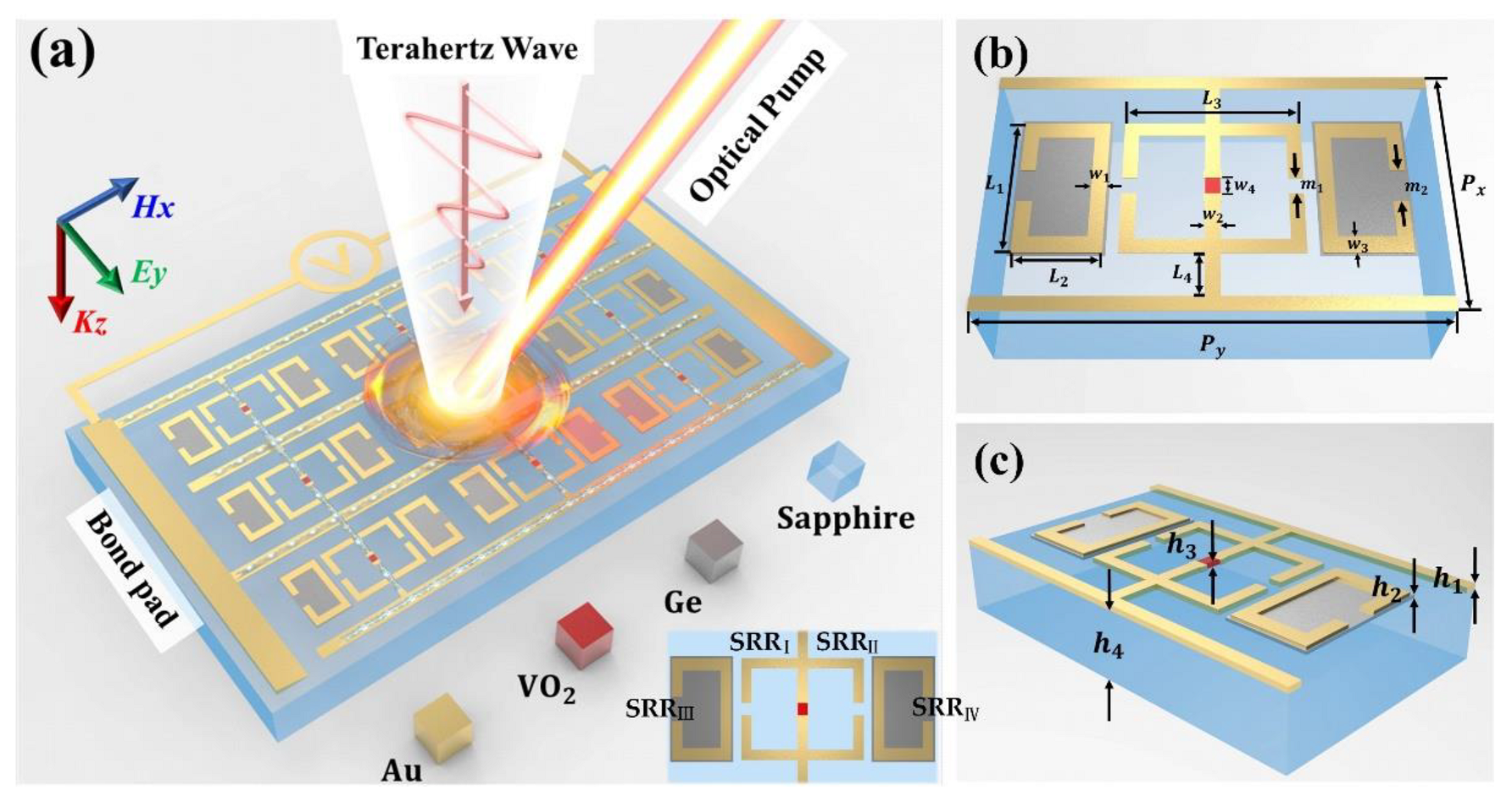
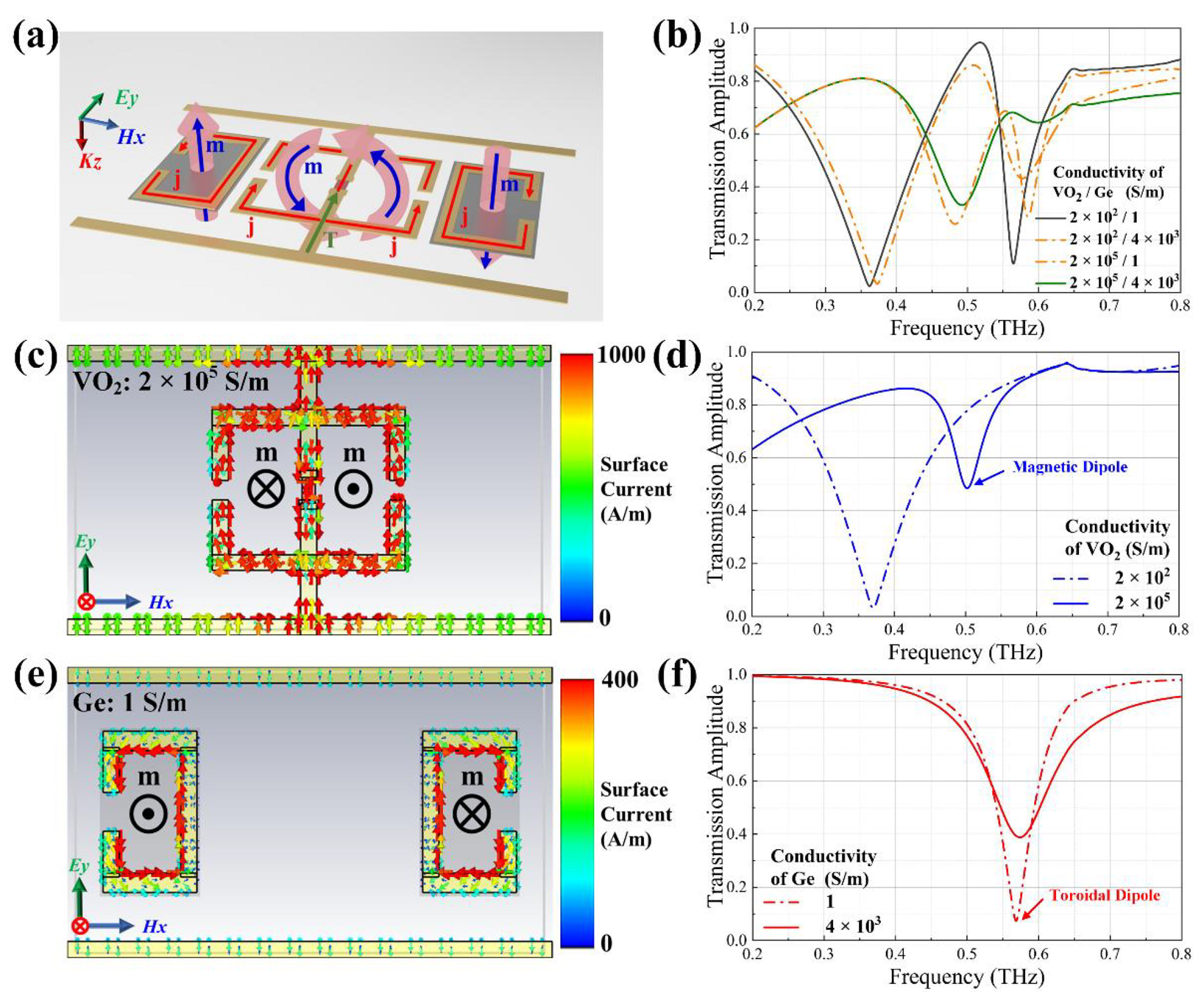
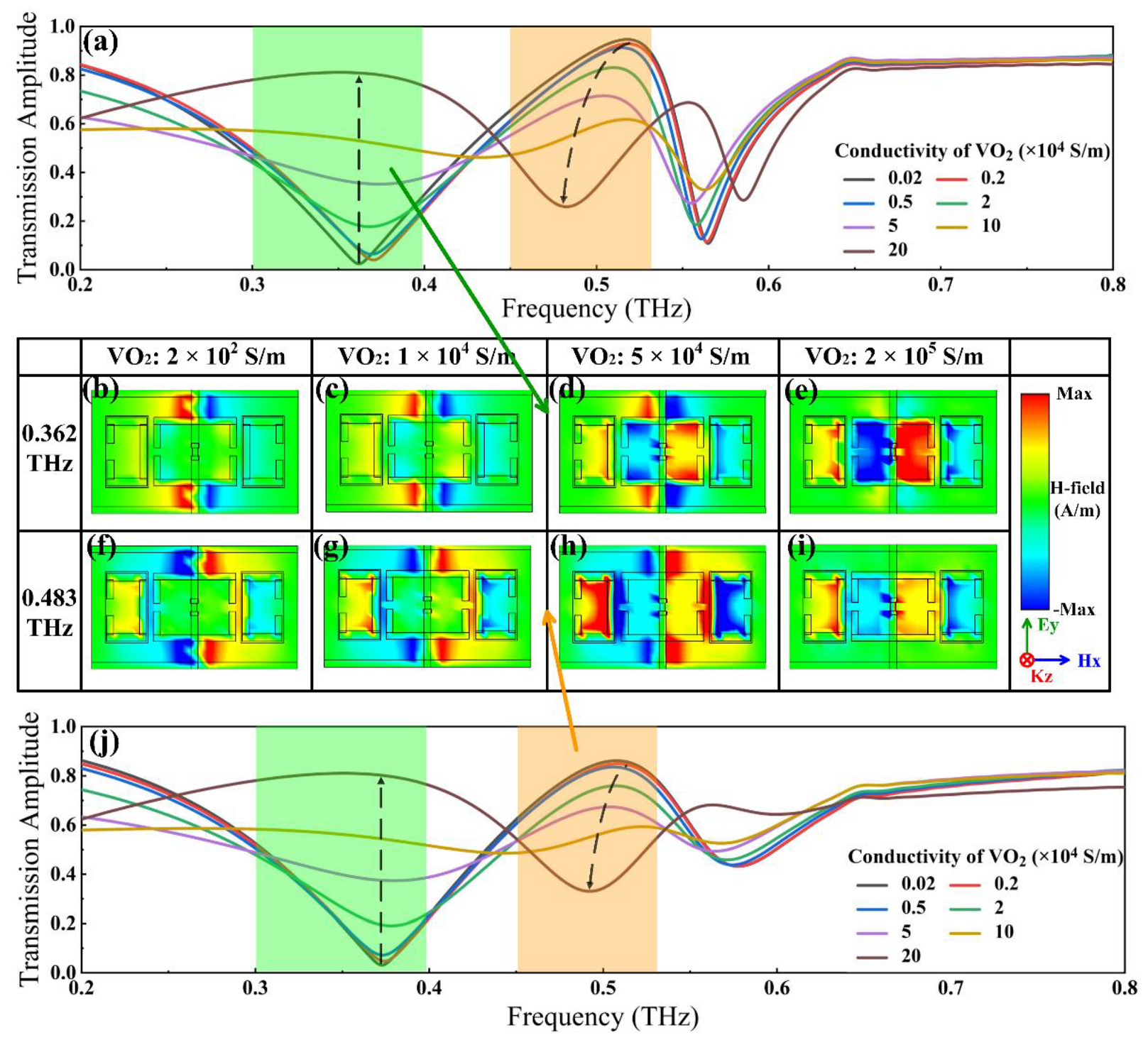
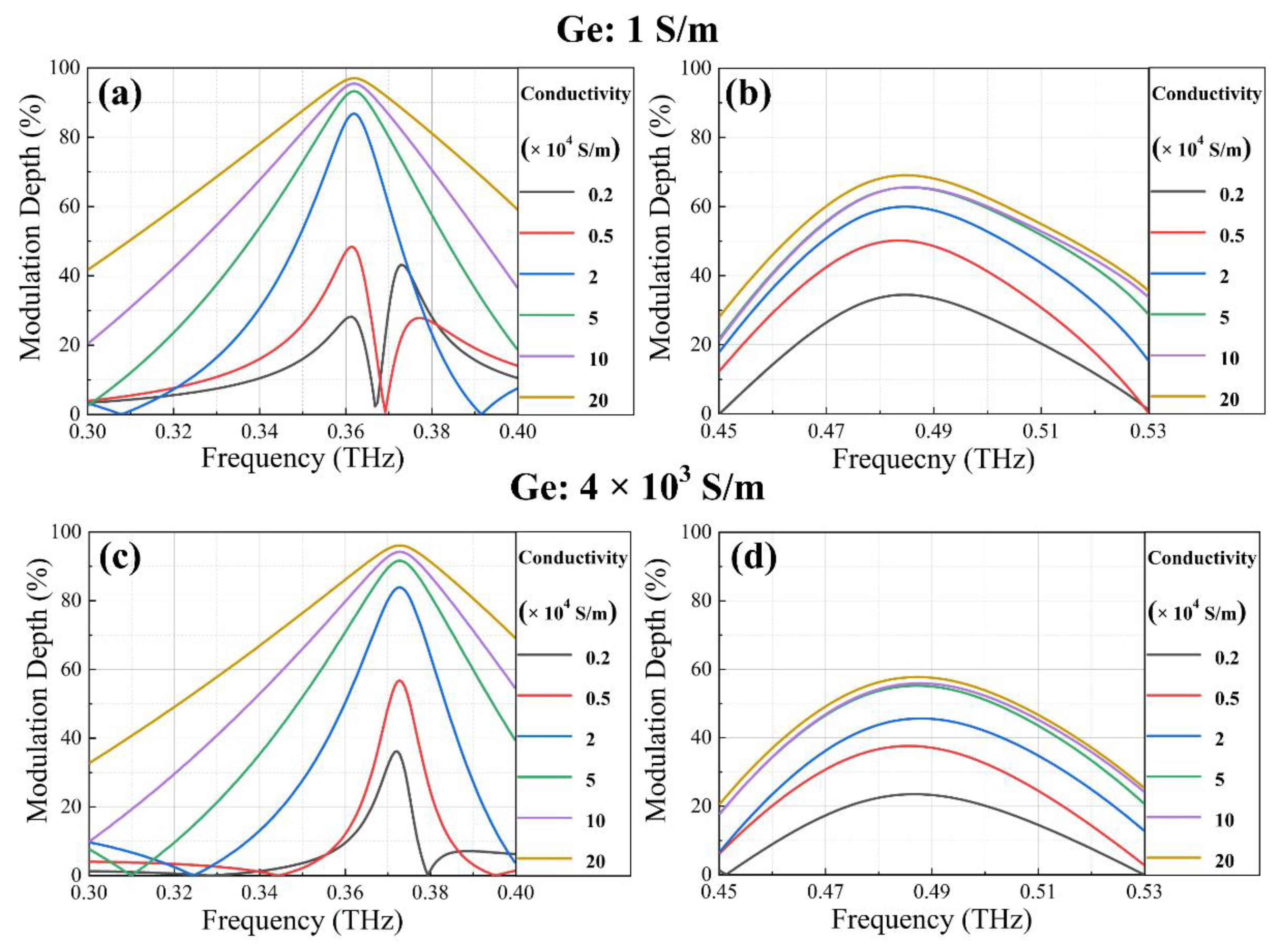
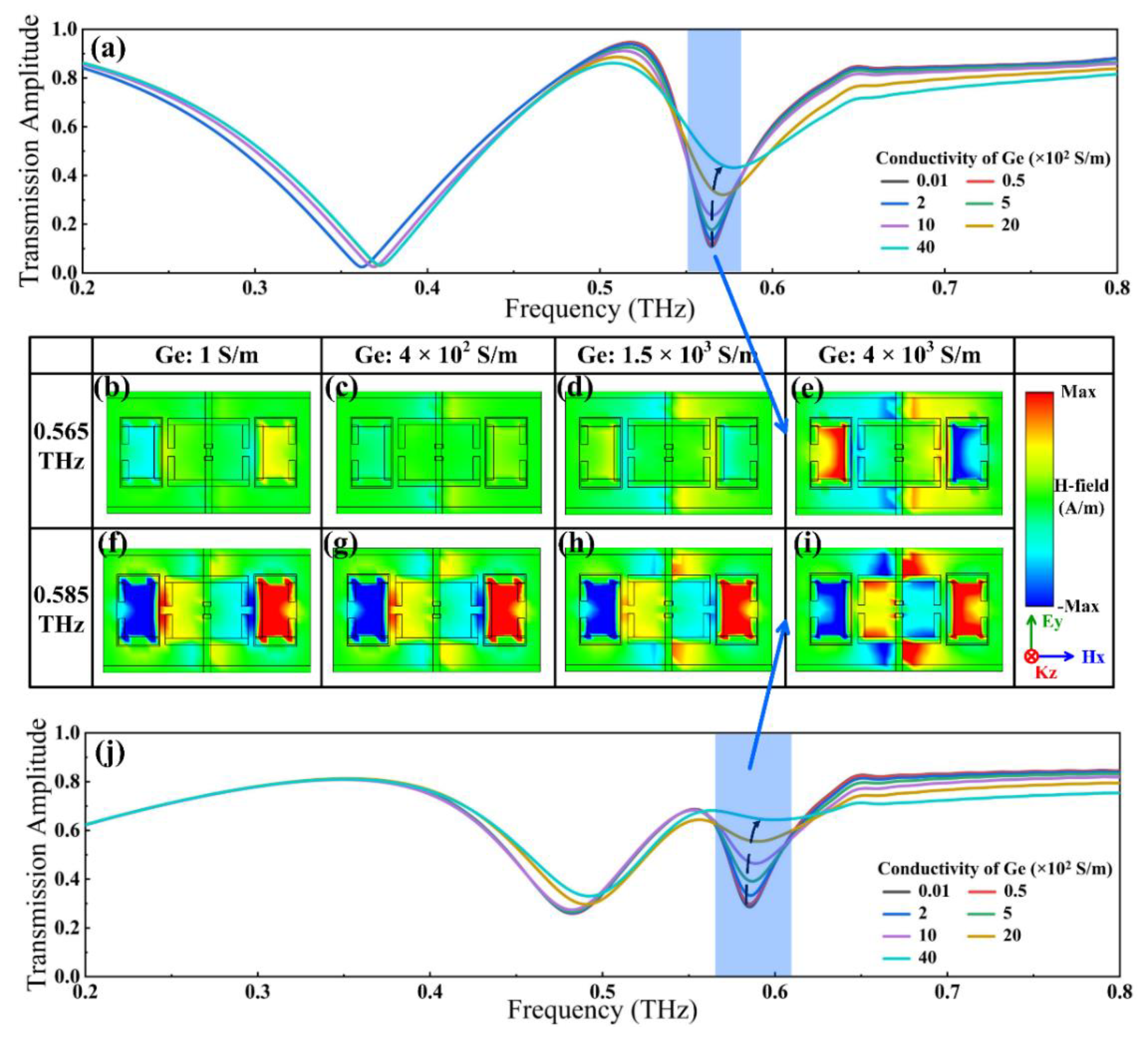
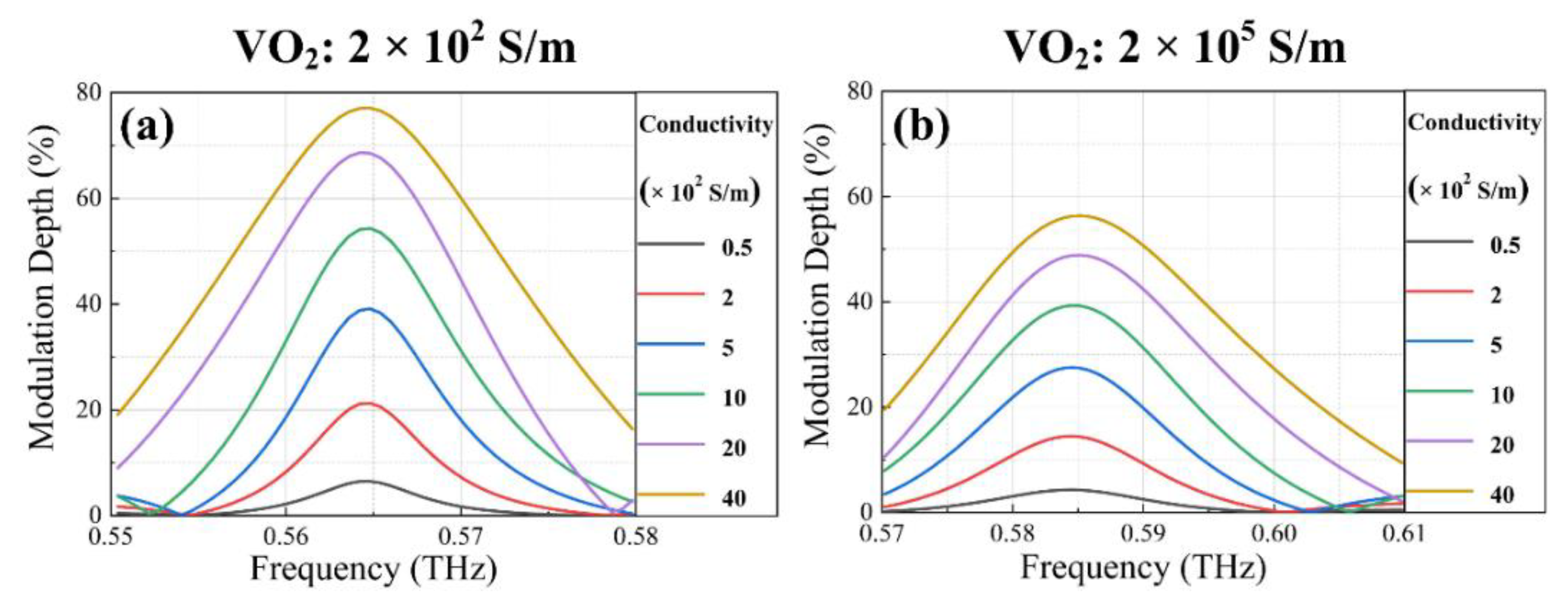
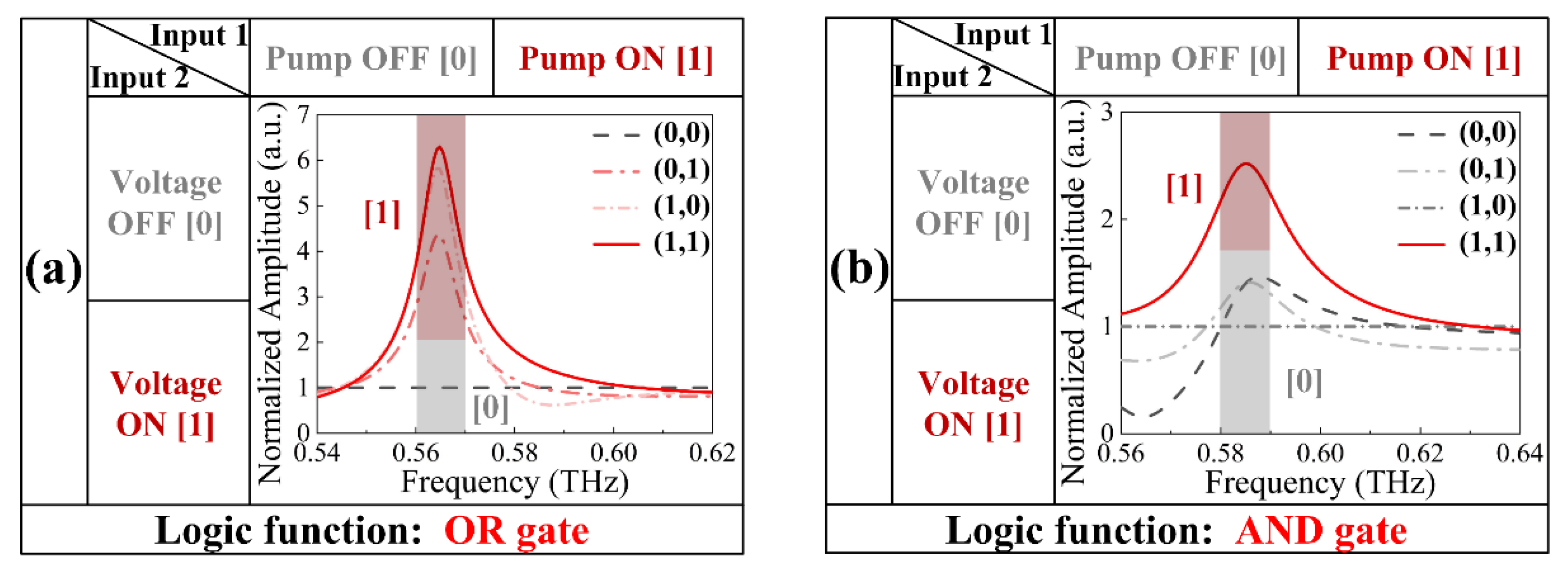
| Px | Py | L1 | L2 | L3 | L4 | w1 | w2 |
|---|---|---|---|---|---|---|---|
| 150 | 90 | 50 | 29 | 60 | 15 | 5 | 5 |
| w3 | w4 | m1 | m2 | h1 | h2 | h3 | h4 |
| 6 | 6 | 6 | 12 | 0.5 | 0.3 | 0.5 | 5 × 105 |
Publisher’s Note: MDPI stays neutral with regard to jurisdictional claims in published maps and institutional affiliations. |
© 2022 by the authors. Licensee MDPI, Basel, Switzerland. This article is an open access article distributed under the terms and conditions of the Creative Commons Attribution (CC BY) license (https://creativecommons.org/licenses/by/4.0/).
Share and Cite
Zhao, X.; Jiao, Y.; Liang, J.; Lou, J.; Zhang, J.; Lv, J.; Du, X.; Shen, L.; Zheng, B.; Cai, T. Multifield-Controlled Terahertz Hybrid Metasurface for Switches and Logic Operations. Nanomaterials 2022, 12, 3765. https://doi.org/10.3390/nano12213765
Zhao X, Jiao Y, Liang J, Lou J, Zhang J, Lv J, Du X, Shen L, Zheng B, Cai T. Multifield-Controlled Terahertz Hybrid Metasurface for Switches and Logic Operations. Nanomaterials. 2022; 12(21):3765. https://doi.org/10.3390/nano12213765
Chicago/Turabian StyleZhao, Xilai, Yanan Jiao, Jiangang Liang, Jing Lou, Jing Zhang, Jiawen Lv, Xiaohui Du, Lian Shen, Bin Zheng, and Tong Cai. 2022. "Multifield-Controlled Terahertz Hybrid Metasurface for Switches and Logic Operations" Nanomaterials 12, no. 21: 3765. https://doi.org/10.3390/nano12213765
APA StyleZhao, X., Jiao, Y., Liang, J., Lou, J., Zhang, J., Lv, J., Du, X., Shen, L., Zheng, B., & Cai, T. (2022). Multifield-Controlled Terahertz Hybrid Metasurface for Switches and Logic Operations. Nanomaterials, 12(21), 3765. https://doi.org/10.3390/nano12213765









